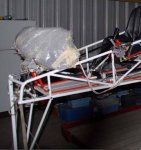- Joined
- Oct 30, 2003
- Messages
- 18,373
- Location
- Santa Maria, California
- Aircraft
- Givens Predator
- Total Flight Time
- 2600+ in rotorcraft
Today we found two pretty serious cracks in the front of the Predator’s frame.
We found a smaller one on one of the mounts for the front body.
I took pictures but they didn’t show the cracks very well.
The cracks in the front are in the upper curved tube.
I would not expect a crack in this area.
The body mount is at the back of the front body coming off the top tube.
Ed is going to try to get some better pictures tomorrow.
We also found some cracks in the exhaust.
I will not be flying this weekend.
It may put off going to Rotors over the Rockies.
I want it to be ready to fly to San Carlos for The Vertical challenge.
I had already found the crack in the body mount.
I would not have found the two cracks in the frame.
If the tubes cracked all the way through the front landing gear might collapse.
This is a good example of how valuable an annual condition inspection is.
We have both a welder A and a welder B so hopefully she can get welded tomorrow. I may end up having to trailer her to welder C. Smokey is out of town until Monday so he is not one of the plans.
The Predator has 770 hours on her and 130 hours with the IO-320 B1A.
We used a bore scope and the engine appears to be a happy engine.
Leak down was good and the spark plugs look happy.
I have to do some fabric repair on the vertical stabilizer.
I am going to repair the dings in the Propeller.
Ed did a great job of mitigating the rust at the frame joints.
I am going to clean up some wiring now that the body is off.
I found a problem with the connector to the antenna for the transponder. We are going to install a new connector tomorrow.
Thank you, Vance
We found a smaller one on one of the mounts for the front body.
I took pictures but they didn’t show the cracks very well.
The cracks in the front are in the upper curved tube.
I would not expect a crack in this area.
The body mount is at the back of the front body coming off the top tube.
Ed is going to try to get some better pictures tomorrow.
We also found some cracks in the exhaust.
I will not be flying this weekend.
It may put off going to Rotors over the Rockies.
I want it to be ready to fly to San Carlos for The Vertical challenge.
I had already found the crack in the body mount.
I would not have found the two cracks in the frame.
If the tubes cracked all the way through the front landing gear might collapse.
This is a good example of how valuable an annual condition inspection is.
We have both a welder A and a welder B so hopefully she can get welded tomorrow. I may end up having to trailer her to welder C. Smokey is out of town until Monday so he is not one of the plans.
The Predator has 770 hours on her and 130 hours with the IO-320 B1A.
We used a bore scope and the engine appears to be a happy engine.
Leak down was good and the spark plugs look happy.
I have to do some fabric repair on the vertical stabilizer.
I am going to repair the dings in the Propeller.
Ed did a great job of mitigating the rust at the frame joints.
I am going to clean up some wiring now that the body is off.
I found a problem with the connector to the antenna for the transponder. We are going to install a new connector tomorrow.
Thank you, Vance
Attachments
-
![001 [HDTV (720)].JPG](https://data2.www.rotaryforum.com/attachments/63/63534-e3f1631700f5340236df45205ac4816f.jpg) 001 [HDTV (720)].JPG32.8 KB · Views: 0
001 [HDTV (720)].JPG32.8 KB · Views: 0 -
![002 [HDTV (720)].JPG](https://data2.www.rotaryforum.com/attachments/63/63535-75d186e37007ef3fe778dfe87af64dc3.jpg) 002 [HDTV (720)].JPG44.5 KB · Views: 0
002 [HDTV (720)].JPG44.5 KB · Views: 0 -
![003 [HDTV (720)].JPG](https://data2.www.rotaryforum.com/attachments/63/63536-9966a77c19dcff12df395ae81af95702.jpg) 003 [HDTV (720)].JPG35.5 KB · Views: 0
003 [HDTV (720)].JPG35.5 KB · Views: 0 -
![004 [HDTV (720)].JPG](https://data2.www.rotaryforum.com/attachments/63/63537-dd200c48e543db4827046dac49125cde.jpg) 004 [HDTV (720)].JPG36.5 KB · Views: 0
004 [HDTV (720)].JPG36.5 KB · Views: 0 -
![005 [HDTV (720)].JPG](https://data2.www.rotaryforum.com/attachments/63/63538-0c2cc4d591c6042a8e266eda044f7244.jpg) 005 [HDTV (720)].JPG62.5 KB · Views: 0
005 [HDTV (720)].JPG62.5 KB · Views: 0 -
![006 [HDTV (720)].jpg](https://data2.www.rotaryforum.com/attachments/63/63539-106b0a6ccd451bb97a0c011962468660.jpg) 006 [HDTV (720)].jpg77.3 KB · Views: 0
006 [HDTV (720)].jpg77.3 KB · Views: 0 -
![007 [HDTV (720)].JPG](https://data2.www.rotaryforum.com/attachments/63/63540-1cb981aba4db6fd6eeb17197ba469d22.jpg) 007 [HDTV (720)].JPG62.6 KB · Views: 0
007 [HDTV (720)].JPG62.6 KB · Views: 0 -
![008 [HDTV (720)].JPG](https://data2.www.rotaryforum.com/attachments/63/63541-3803bdb95ee69d3c56f797941fe53edc.jpg) 008 [HDTV (720)].JPG51.2 KB · Views: 0
008 [HDTV (720)].JPG51.2 KB · Views: 0


![006042010 018 [HDTV (720)].jpg](https://data2.www.rotaryforum.com/attachments/63/63552-24b51b8524ca4b3592a436c731ae8555.jpg)
![006042010 039 [HDTV (720)].JPG](https://data2.www.rotaryforum.com/attachments/63/63553-3dde6d51184821e3eca9f40dd237223a.jpg)
![006042010 041 [HDTV (720)].JPG](https://data2.www.rotaryforum.com/attachments/63/63554-2fb62305c292c7728a1d349829a07393.jpg)
![006042010 042 [HDTV (720)].JPG](https://data2.www.rotaryforum.com/attachments/63/63555-bdd821dddbb5a96011eaa4b957b1e10f.jpg)
